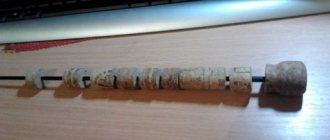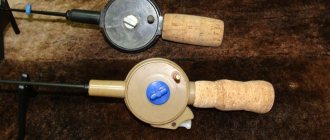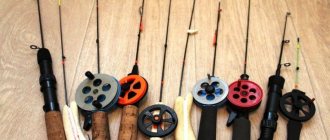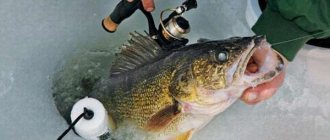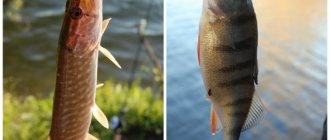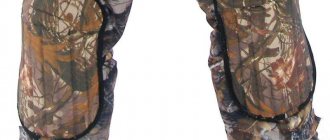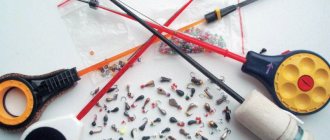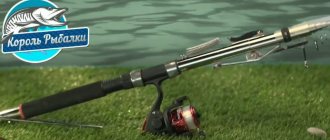A self-made winter fishing rod (see picture) is a rather ancient piece of equipment used for fishing in the winter season.
The main difference from modern gear on a homemade fishing rod is the absence of a reel and the presence of a squat stand, which serves as a reel for reeling in and attaching winter equipment.
Interested fishermen are offered for consideration three of the simplest do-it-yourself designs of filly fishing rods, which are equally convenient for winter fishing with a jig and float, as well as with a spinner.
The invention was found in an old fishing magazine and, against the backdrop of the offer in stores of the same purpose, elegant winter fishing rods for fillies, perhaps it will only cause a condescending grin among some fishermen. But don't rush to hasty conclusions.
Wooden and foam fishing rod
Firstly: a hand-made wooden filly fishing rod has much more weight than a similar fragile foam fishing rod. Therefore, it is more difficult to put the fishing rod on its side or drag it during winter fishing in a gust of wind on smooth ice, which is especially important when fishing with several winter float rods at the end of winter or from the first smooth ice.
Secondly: handmade wooden crafts are easily painted in bright colors, so they are visible against the background of snow, and, thanks to their rigid construction, they are not very afraid, unlike a foam fishing rod, of accidentally ending up under a heavy fishing boot.
In the longitudinal cavity of a wooden fishing rod, the seat of the winter tackle whip practically does not wear out, and a rigid sleeve is usually glued into the round foam plastic cavity.
In addition, the design of any wooden filly fishing rod for winter fishing can be easily improved with your own hands at home. Let's say you can add a reel to a fishing rod with a jig on top and equip it with a reel of fishing line with a winter sheer lure attached.
The solid wooden handle allows you to hollow out a cavity in it in the form of a pencil case, similar to the one present in an ice fishing box, and store replaceable jigs and spinners in it while fishing. And so on.
The last argument. Any rural fisherman, deprived of the urban benefits of civilization, can make his own fishing rods from a wooden block, just as anyone can make similar gear not from wood, but from a dense foam plastic blank.
How to make a wooden filly fishing rod
First, let’s figure out how you can make a wooden filly fishing rod with your own hands according to the dimensions indicated in the drawing, then we’ll equip a homemade fishing rod.
We read the author's text. If any of the fishermen find my explanations highlighted in blue unnecessary, then just skip them.
The inventor of winter fishing rods of unique design is A. Chervyakov, Moscow. Let me remind you that the text is taken from an old magazine.
“Walk on the ice of a reservoir on a winter day and take a closer look at winter fishing rods. What a variety of models, sizes, shapes, colors! There are factory ones, but, perhaps, there are more homemade foam plastic ones.
And among all this diversity, I guarantee that you will not see the wooden winter fishing rod “filly” described by L.P. Sabaneev. Why do fishermen, especially urban ones, neglect the good old “filly” fishing rod? I think the reason is not that it is difficult to make such a winter fishing rod with your own hands, but because of following fashion.
Small winter plastic fishing rods that fit in the palm of your hand and are used by athletes are fashionable these days. Apparently, here the author of the article means winter balalaika fishing rods. Elegant, also small winter foam float fishing rods are popular.
But... Are tiny winter fishing rods convenient for everyone, which not all fishermen can make with their own hands? Can everyone hold such a fishing rod in their hand for a whole winter day? What about older people with deformed joints?
Maybe it makes sense for them to remember the homemade wooden winter fishing rod? What's good about her? The filly is “graspy”, that is, it is convenient for picking up by hand, it is stable on the ice - it can be placed near the hole, and not constantly held in the hand, and at the same time it is not afraid of the wind. The fishing line on the reel of the fillies is wound and reeled in without difficulty, and any fisherman who is not lazy can make such wooden tackle.
Let me add: a do-it-yourself winter fishing rod made from wood or polystyrene foam is practically unsinkable. Even large fish are unlikely to be able to get such a large float under the ice.
In addition, foam and wooden fillies have low thermal conductivity. As a result, fishermen holding such a fishing rod in their hands during the cold winter season have less cold hands than when fishing with a fishing rod with a handle made of plastic.
True, the fillies described in the literature are somewhat rough, but you can make a winter fishing rod more elegant, more modern, or something.
This is the goal I set myself - to make with my own hands from available wooden materials a filly that would please the eye with its appearance. Already in the process of work, I came up with three options for winter fishing rods for fillies.
Features of equipment for winter fishing rods
The design of winter models for trolling does not play as big a role as their equipment. She is the one responsible for a successful catch. Equipment options depend on the fishing method.
Tips for fisherman: In what weather does fish bite better in winter - Answers for beginners
1. Stationary fishing. In this case, the nozzle stands motionless in the water column or at the bottom, bites are transmitted using a nod. The equipment is selected according to the degree of its elasticity so that the fish cannot feel their weight and swallow the bait without fear. These can be light jigs attached to a thin fishing line. It is important that they provide synchronous play with the nod.
- 2. Fishing in the current. In this case, special weighted equipment is used that can be held in the water flow and remain very sensitive. They necessarily contain lead leads and heavy sinkers, which can be replaced with a feeder set assembled using inline technology.
- test from 15 grams to 65 grams.
Materials for making a filly fishing rod
So, what materials and tools are needed to make wooden filly fishing rods with your own hands?
Tools: knife, file, sandpaper (not very large), drill, drills with a diameter of 4, 6 and 10 millimeters, jigsaw, screws, safety razor blade.
Materials: wooden blocks measuring 25X25X100, 30x35x100 and 30x45x100 millimeters, PVA, BF or “Moment” glue, wooden spools for thread with a diameter of 30 and 25 millimeters, cork, threaded caps from a simple ballpoint pen. See drawing 1.
On the filly handle blank (a wooden block measuring 25X25X100 millimeters) we mark future bevels, roundings, axes for installing the reel and the whip holder. (The fishing rod drawing is shown at the top of the page.)
Making a fishing rod with your own hands
In order to make a fishing rod with your own hands, you need a minimum of time and the necessary components.
- Coil.
- Hollow glass whip.
- Thin coal whip.
- Champagne corks – 5 pieces.
- A few rings (but not tulips).
- Paper clips – 2 pieces.
The whole process boils down to this:
- You should cut off a piece of material 31 cm long from a carbon fiber whip. And twist it into something like a thin tube.
- Next you need to cut off 30 cm from the coal whip, which will serve as an “elbow”.
- After this, you will need to find champagne bottles, dry them well, and then drill them and put them on the handle of the future tackle. To prevent them from moving out, it is better to glue them to each other, as well as to the main product.
- Next you will need to sand the handles.
- After this, you will need to insert the second knee and the whip, take the plug and glue it well.
- Then you will need to strengthen the edges of the knees with nail polish and thread, and then glue the rings. You can use paper clips instead.
- At the last stage, it will be necessary to trim the place on the cork where the coil will be attached, and then glue it with glue and additionally wrap it with electrical tape.
This way you will get a convenient and inexpensive fishing rod for winter trolling.
Making a wooden filly fishing rod
To make the handle of a homemade winter fishing rod, we drill a hole with a diameter of 6 millimeters from one of the ends of the wooden block to a depth of 10 millimeters - we will then insert the whip holder into it.
The proposed dimensions of the hole for fixing the whip holder of the winter fishing rod in the filly are too small. The entry into the wooden block should be at least 30 millimeters long. Otherwise, the whip will constantly fall out of its seat in the handle.
We continue this hole, but drill it to the end of the wooden block using a 4 mm drill. We will put the whip into it in the stowed position.
Stationary fishing
Stand-up fishing is a classic of winter fishing that many beginners start with. It’s easiest to make a winter float rod (or nod) for stand-up fishing. There are no requirements for such a fishing rod that affect the performance of the jig. The main function is to store a supply of fishing line, ease of installation on ice, and quickly bring it into working position. The basic design is simple:
- A device for storing fishing line (reel or reel);
- Handle (often together with a reel, as on a filly, or with a reel, as on a balalaika);
- Whip;
- Legs (optional).
The specific option depends on what the fisherman is going to make a winter fishing rod from. It is not the peculiarities of fishing tactics that are of great importance, but rather the personal preferences of anglers. An absolute plus of homemade products is that everything is made for yourself. The process of making winter fishing rods with your own hands with a float or nod, in essence, connecting the whip and handle, reel (reels) into a single whole. In stationary fishing, the equipment of the fishing rod itself is more important, and not the fishing rod, which performs secondary functions. Therefore, when making or thinking through the design of a fishing rod, an angler can take certain liberties.
fillies
The simplest do-it-yourself winter fishing rod, a filly, is made from a piece of hard foam or other similar material. Previously, the filly's body was carved from wood. Now it is advisable to use polystyrene foam or other plastics - they are easy to obtain and process. And they are much lighter in weight than wood. The process of making a winter fishing rod from polystyrene foam or polystyrene foam with your own hands takes a few minutes. Reels are cut from a block of material with a knife, then the workpiece is processed with sandpaper or a file. The whip is glued into the filly with epoxy resin or any glue that does not dry out in the cold and does not corrode the foam.
As a whip, you can use store-bought polycarbonate or vinyl sixes, fragments of summer gear, as well as improvised materials - for example, plastic knitting needles from an umbrella or the feathers of a broom. In principle, such a fishing rod can already be used on a pond. The line is wound onto the reel, passed through the cambric (nod connector) on the whip and equipped. If you get confused, you can devote more time to this workpiece for the sake of ethical beauty - properly sand it, paint it.
With handle and reel
You can make a fishing rod for winter fishing with a reel. This type of gear is more convenient for use at depth. Making it is not much more difficult than a filly. The principle is the same, just instead of cutting out the reel, a reel is attached to the handle. The handle of such a winter fishing rod is made by hand from any suitable materials. Polystyrene foam, cork, wood, mop handles, fluoroplastic, plastics - the list goes on and on. The simplest way is to put several wine corks on a whip and place it on glue. A homemade winter fishing rod with a reel is made in various versions, as long as the design meets the fishing requirements. There are a lot of homemade products on the pond. This is a huge field for experimentation.
An important point is to think in advance about the result you want to get. A lightweight small fishing rod is suitable for catching small fish in the shallows. When fishing in currents and depths with bottom rigs, you will need a fairly massive fishing rod that can stand stably above the hole when the current affects the fishing line. You can attach a lead plate to the handle for counterweight - so that the fishing rod does not dive like a whip into the hole. A good idea can be borrowed from winter trout fishermen - place a 20 cm student's ruler on the whip. Then a large crucian carp or bream will not be able to drag the fishing rod into the hole from a gaping angler.
Fishermen often engage in making homemade winter fishing rods just for the sake of the process. At the same time, do not forget about the fishing conditions for which the tackle is made. It is impossible to fully describe all the options - each master considers his own design to be the best. For practicality purposes, the simpler the better. If there is a desire to tinker, we collect more complex options while passing the time in the off-season. If you try, you can carve a balalaika from wood. The end result is to achieve smooth rotation of the coil in the cut-out niche. The simplest winter fishing rod and reel with your own hands is a whip, a handle and a small summer reel attached to it with electrical tape. For stand-up fishing, it is useful to equip fishing rods with legs.
Legs
When equipped with a float, the fishing rod can simply be placed on the ice next to the hole when fishing. But for nodding installations, the whip is placed directly above the hole for the correct position of the guard. For ease of installation, such fishing rods are equipped with legs. You can make legs for a winter fishing rod with your own hands from any suitable materials. The simplest thing is to twist a wire or attach an ordinary clothespin to a whip. The trout fishing ruler is both legs and protection against the tackle being dragged into the hole.
Equipment
If the configuration of the fishing rod allows some liberties in the design, then the equipment requires increased attention from the angler. This is the most important part of the tackle, which catches fish directly. Depending on the fishing conditions and the type of fish, various winter rigs are used, with a nod or a float. The float rig is adjusted so that when lifting the hook with a hook (jig) from the bottom, the fish does not feel the weight of the bait. To do this, the float and weight are adjusted so that the entire equipment has a slightly negative buoyancy. This is the only way the float will compensate for the weight of the bait when it surfaces. About float equipment in winter.
Nodding installations are made according to the same principle. Here the compensating function is performed by a correctly configured guard. About the nodding winter rigging of fishing rods.
Homemade foam fishing rod filly
You can make the handle of a homemade winter fishing rod with your own hands from a foam block by cutting out a piece of foam according to the dimensions suggested in the drawing above using a hacksaw blade for metal. Just don’t rush, otherwise the foam blank will begin to melt, clogging the teeth of the canvas.
The cap of a ballpoint pen does not have to protrude beyond the surface of the filly's foam winter fishing rod. It can be recessed inside a homemade foam handle.
An incorrectly burned hole can always be clogged with foam plastic crumbs coated with glue. The strength of the surface of holes burned into foam plastic is unlikely to be inferior to that of wooden cavities.
Now you can use a knife to shape the wooden or foam block and smooth out the irregularities with sandpaper. Having made the handle of a homemade filly fishing rod (wooden or foam) with our own hands, we proceed to the installation of parts and equipment.
Reel of a homemade filly fishing rod
Next, the filly should mount a reel on a homemade fishing rod, which will also serve as a support for winter tackle.
To do this, cut a wooden spool of sewing thread with a bobbin cheek diameter of 30 millimeters in half using a jigsaw (slot or hacksaw). We clean the cut areas with sandpaper and lubricate them with glue.
We also apply glue to the handle of the filly, glue the halves of the coil and, for greater strength, fasten them (through the holes) with screws. When making a reel with your own hands, make sure that the heads of the screws do not fall inside the holes in the halves of the wooden reels.
After the glue has dried, we clean the completely hand-made wooden winter fishing rod once again with sandpaper and either paint it in a bright color, or treat it with stain and impregnate it with drying oil.
When the paint or drying oil has dried, use a sharp knife or razor blade to cut two disks approximately 3 millimeters thick from the cork (cork tree bark) and glue them to the top of the filly’s handle along the same axes as the halves of the wooden spools.
Cork discs will serve to attach a hook or jig to a homemade winter fishing rod.
For the same purposes, thin, dense foam rubber can be used, which can be changed periodically. And what’s stopping us from installing a container for storing and transporting jigs or spinners inside the filly’s foam winter fishing rod?
When finished, the wooden “filly” turns out to be beautiful, stable on ice and an easy-to-use homemade winter gear.”
Equipment according to fish type
The types of equipment depend on the type of production.
1. Roach fishing. To do this, take light fishing rods that work with fishing line with a diameter of 0.06 to 0.1 millimeters, artificial baits, and small jigs.
2. Perch fishing. Forms of medium hardness with removable reels, fishing lines with a diameter of 0.12 to 0.16 millimeters, cone-shaped nods up to 10 centimeters high, brass, silver or copper balancer spinners with a length of 7 to 10 centimeters are used.
3. Pike fishing. It uses high-power fishing rods with whips from 40 to 50 centimeters long, multiplier reels for fluorocarbon fishing line, and braided cord with a diameter of 0.26 to 0.3 millimeters. To prevent the pike from biting them, you need to attach a leash made of Kevlar, guitar string. In this case, you need fish-shaped balancers from 5 to 10 centimeters long, which cling to the leash using swivels equipped with carabiners.
4. Bream fishing. For the equipment you need a small supply of fishing line with a float without a jig, with a hook on which there is edible bait. No additional loading required. In winter, bream does not catch at great depths.
5. Fishing for pike perch. For fishing you will need a powerful fishing rod with a smooth action, monofilament or fluocarbon fishing line with a diameter of 0.25 to 0.35 millimeters. When using artificial baits, you can fish without nodding. Spoons should have an oblong shape and a length of 7 to 10 centimeters.
Tips for fisherman: Reel for winter trolling with a friction clutch - Let’s take it step by step
6. Fishing for crucian carp. Fishing rods are equipped with lavsan nods or thin metal plates replacing them, soft guards with high sensitivity and a length of 15 to 20 centimeters. For fishing you will need a fishing line with a diameter of 1.12 to 0.16 centimeters, a strong and thin hook with a small groove, tungsten jigs of brass, copper, silver, and red.
The choice of spinners in stores today is extremely large. But many people make them on their own; you can find enough materials at hand.
Homemade winter fishing rod filly
In the second version of the homemade winter fishing rod, the reel for winding the equipment is placed on top of the handle. For ease of gripping winter gear by hand, there is a recess at the base of the stand. At home, it can be cut while processing the workpiece (a block measuring 30x35x100 millimeters).
I would advise making this version of the filly fishing rod with your own hands, also from dense foam. The handle can be given a U-shape using the same method in which the internal cavity is cut out in a homemade foam box of a blood bottle.
The channel for attaching a homemade whip to the body of a winter fishing rod can also be drilled or burned in the desired direction, for example, with a stripped welding electrode.
Having marked the workpiece and drilled holes for the whip holder and its storage in a homemade fishing rod in the transport position, use a jigsaw or hacksaw to cut a notch in the center of the base and use a knife to process the block to the end.
We take a wooden spool (spool) for the reel that is thinner than in the first option - with a diameter of 25 millimeters. To prevent the mounting screws from protruding above the reel, we first countersink the holes in the halves of the reels with a drill with a diameter of 10 millimeters.
In the first option for making a homemade winter fishing rod, the holes for the screw heads in the halves of the reels should also be countersunk with a drill or cut out with the sharp end of a knife.
Features of choosing gear
When considering a particular fishing rod model, you should definitely pay attention to the following points:
- The level of rigidity of the rod and the equipment with a nod;
- Coil design;
- Rod length;
- Shape and material of the handle;
- The total weight of the gear.
Tips for a fisherman: How to properly catch pike on girders in winter - Answers for beginners
If you are going to a body of water where pike and pike perch bite well in the winter months, then you should choose a fishing rod with a fairly stiff rod. Excessive softness of the whip can lead to uncertainty in breaking through the mouth of a predatory fish during hooking. If you are going to catch small-sized predators using a balance beam or a spoon, then it is advisable to equip it with a guard. The presence of a nod guarantees that you will receive a timely signal of a bite, which is difficult to miss.
As for the reel for winter lure fishing, it should be of the open inertial type. It is the one that is better than others for monitoring the speed and density of the line winding at the time of landing fish. In addition, for comfortable fishing for pike and pike-perch, it is desirable to have a braking system, because it, together with the level of rigidity of the rod, is responsible for how high-quality your hooks will be.
If we talk about the shape of the handle, then it should be such that during long-term use of the equipment you do not have a feeling of discomfort. To do this, when choosing a fishing rod, hold several models and buy the one that seems most convenient. It is also worth paying attention to the material from which the handle is made. If it is plastic, then refuse to purchase such equipment, because it is too cold. It is better to choose a fishing rod with a neoprene or cork handle that can retain heat.
If we talk about the total weight of the gear, then it should be small, because this way you will get less tired while fishing. This feature is not so important when fishing for small predatory fish when you are using a model with a light rod and reel. However, if large predators live in a reservoir, then you should not deliberately reduce the total weight of the fishing rod, making it less reliable and durable.
As I already said, there is nothing complicated in making this gear, because, in fact, we just need to make the following elementary items and connect them into one whole:
